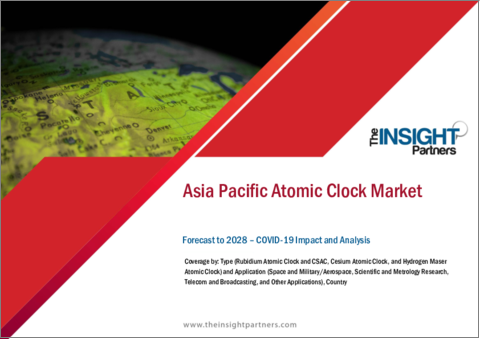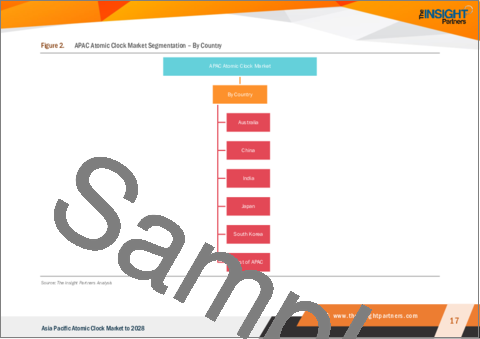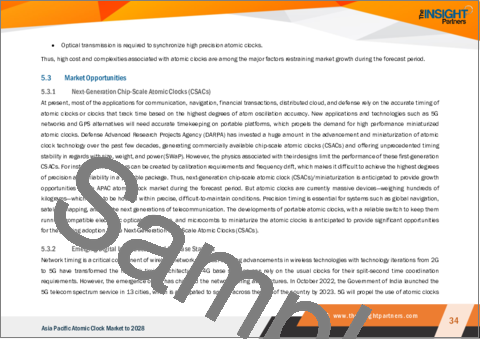|
|
市場調査レポート
商品コード
1206516
アジア太平洋地域の原子時計市場の2027年までの予測- タイプ別、アプリケーション別の地域分析Asia Pacific Atomic Clock Market Forecast to 2027 - COVID-19 Impact and Regional Analysis by Type, and Application |
||||||
| アジア太平洋地域の原子時計市場の2027年までの予測- タイプ別、アプリケーション別の地域分析 |
|
出版日: 2023年01月20日
発行: The Insight Partners
ページ情報: 英文 100 Pages
納期: 即納可能
|
- 全表示
- 概要
- 図表
- 目次
アジア太平洋地域の原子時計市場は、2022年の1億2,514万米ドルから2028年には1億9,166万米ドルに成長すると予測されています。2022年から2028年までのCAGRは7.4%で成長すると推定されます。
デジタルインフラと5G基地局の出現がアジア太平洋地域の原子時計市場に有利な機会をもたらすと予想される
ネットワークのタイミングは、ワイヤレスネットワークサービスの重要な要素です。2Gから5Gへの技術革新に伴い、ワイヤレス技術の進化が進み、ネットワークタイミングアーキテクチャが変化しています。4Gの基地局は、スプリットセカンドの時間調整要件に対して、通常のクロックに頼ることができます。しかし、5Gの登場により、ネットワーク・タイミング・アーキテクチャが変化しています。2022年10月、インド政府は13都市で5G通信スペクトルサービスを開始し、2023年までに残りの都市に普及すると予想されています。5Gは、原子時計とアンテナの使用を推進し、電話やセンサーに独自のデータビームで追従し、異なるタスクのためにネットワークを分散させることができます。通常の時計は、高速なデータ移動に対応できるほど標準化されていません。そのため、世界中の5Gネットワーク構築者は、精度と正確さを求めて原子時計を要求しています。例えば、2019年11月、ボーダフォンは、GPSネットワークがダウンした場合にネットワークに正しい時刻を提供するために、イリジウム原子時計を基地局に設置すると発表しました。したがって、デジタルインフラ、特に、5G基地局の設置の増加は、より高いデータレートと低遅延のための信頼性の高いタイミングのための原子時計の需要を押し上げると予想されます。これらの要因が、アジア太平洋地域の原子時計市場に有利な機会を提供すると予想されます。
アジア太平洋地域の原子時計市場の概要
原子時計の生産量の増加は、アジア太平洋地域の市場成長を促進する主要な要因の一つです。アジア太平洋地域では、中国と日本がセシウムと水素メーザー原子時計の主要生産国です。また、インド宇宙研究機関(ISRO)は、セシウムと水素メーザーを用いた独自の原子時計アンサンブルを開発しています。また、ISROはルビジウムを用いた高精度な原子時計の開発にも取り組んでいます。さらに、中国はアジア太平洋地域の原子時計市場において、最も大きな収益貢献をしている国の一つです。中国は2021年に37.28%の市場シェアを獲得し、アジア太平洋地域市場をリードしています。2020年7月にBeiDou航法衛星システム(BDS)の正式な試運転を宣言し、世界のユーザーが正式に利用できることを示しました。BDSシステムには、400以上の機関と30万人の研究者・技術者が関わっています。衛星開発会社である中国宇宙技術研究院(CAST)は、国内の主要な専門家やメーカーを集め、このプロジェクトのために最先端の技術や高品質の材料・製品を統合しました。ルビジウム原子時計は、BDS衛星に時間と周波数の標準を提供し、これらの時計はシステムの測位、速度測定、タイミング精度に重要な役割を果たします。西安支店では、過去20年間に70個の高精度クロックを含む100個以上のルビジウム原子時計をBDS計画に納入しています。さらに、世界の原子時計市場では、アジア太平洋地域が最も高いCAGRを記録すると予想されています。インドや中国などの国々で、航空、通信、放送アプリケーションの衛星アンテナに原子時計の使用が増加していることが、予測期間中にこの地域の市場成長を後押しすると予想されます。2022年11月、中国の天宮宇宙ステーションの最終モジュールがコア構造物とドッキングし、同国の宇宙開発における画期的な瞬間が完成しました。このモジュールには、微小重力を研究し、流体物理学、材料科学、燃焼科学、基礎物理学の実験を行うための科学機器と、世界初の宇宙ベースの冷原子時計システム、宇宙で最も正確な時間と周波数システムを形成し、何億年も1秒を失わない時計システムが搭載されました。このような市場開拓は、アジア太平洋地域の原子時計市場の成長を促進すると予想されます。
アジア太平洋地域の原子時計市場の収益と2028年までの予測(金額)
アジア太平洋地域の原子時計市場のセグメント化
アジア太平洋地域の原子時計市場は、タイプ、アプリケーション、国別に分類されます。
タイプ別では、アジア太平洋地域の原子時計市場は、ルビジウム原子時計とCSAC、セシウム原子時計、水素メーザー原子時計に区分されます。2022年には、ルビジウム原子時計とCSACセグメントがアジア太平洋地域の原子時計市場で最大のシェアを記録しました。
アプリケーションに基づき、アジア太平洋地域の原子時計市場は、宇宙・軍事・航空宇宙、科学・計測研究、通信・放送、その他のアプリケーションに区分されます。2022年には、宇宙・軍事・航空宇宙分野がアジア太平洋地域の原子時計市場で最大のシェアを記録しました。
国別に見ると、アジア太平洋地域の原子時計市場は、オーストラリア、中国、インド、日本、韓国、その他アジア太平洋地域に区分されます。2022年には、中国セグメントがアジア太平洋地域の原子時計市場で最大のシェアを記録しました。
AccuBeat Ltd、Excelitas Technologies Corp、IQD Frequency Products Ltd、Leonardo SpA、Microchip Technology Inc、Orolia、Oscilloquartz SA、Stanford Research Systems Inc、およびTekron International Ltdは、アジア太平洋地域の原子時計市場で活動している主要企業です。
目次
第1章 イントロダクション
第2章 重要なポイント
第3章 調査手法
- カバレッジ
- 2次調査
- 1次調査
第4章 アジア太平洋地域の原子時計市場の展望
- 市場概要
- アジア太平洋地域のPEST分析
- エコシステム分析
- 専門家の見解
第5章 アジア太平洋地域の原子時計:市場力学
- 市場促進要因
- 航空宇宙・軍事分野における高精度原子時計へのニーズの高まり
- 時間に敏感なアプリケーションに起因する計測ステーションからの高い需要
- 市場抑制要因
- 原子時計に関連する高コストと複雑さ
- 市場機会
- 次世代チップスケール原子時計(CSACs)
- デジタルインフラと5Gベースステーションの出現
- 今後の動向
- ストロンチウム、イッテルビウム、ガドリニウム原子の光学格子に基づく原子時計
- 促進要因と抑制要因の影響分析
第6章 原子時計市場-アジア太平洋地域分析
- アジア太平洋地域の原子時計市場の概要
第7章 アジア太平洋地域の原子時計の市場分析:タイプ別
- アトミッククロックの概要
- アジア太平洋地域の原子時計市場:タイプ別(2021年、2028年)
- ルビジウム原子時計とCSAC
- セシウム原子時計
- 水素メーザー原子時計
第8章 アジア太平洋地域の原子時計の市場分析:アプリケーション別
- アジア太平洋地域の原子時計市場:アプリケーション別(2021年、2028年)
- 宇宙および軍事/航空宇宙
- 科学と計測研究
- テレコム、放送
- その他のアプリケーション
第9章 アジア太平洋地域の原子時計市場:国別分析
- アジア太平洋地域
- オーストラリア
- 中国
- インド
- 日本
- 韓国
- アジア太平洋地域のその他諸国
第10章 業界情勢
- 市場の取り組み
- 新製品開発
- 合併・買収
第11章 企業プロファイル
- AccuBeat Ltd
- Excelitas Technologies Corp
- IQD Frequency Products Ltd
- Leonardo SpA
- Microchip Technology Inc
- Orolia
- Oscilloquartz SA
- Stanford Research Systems Inc
- Tekron International Ltd
第12章 付録
List Of Tables
- Table 1. APAC Atomic Clock Market - Revenue and Forecast to 2028 (US$ Million)
- Table 2. Australia: Atomic Clock Market, by Type -Revenue and Forecast to 2028 (US$ Million)
- Table 3. Australia: Atomic Clock Market, by Application -Revenue and Forecast to 2028 (US$ Million)
- Table 4. China: Atomic Clock Market, by Type -Revenue and Forecast to 2028 (US$ Million)
- Table 5. China: Atomic Clock Market, by Application -Revenue and Forecast to 2028 (US$ Million)
- Table 6. India: Atomic Clock Market, by Type -Revenue and Forecast to 2028 (US$ Million)
- Table 7. India: Atomic Clock Market, by Application -Revenue and Forecast to 2028 (US$ Million)
- Table 8. Japan: Atomic Clock Market, by Type -Revenue and Forecast to 2028 (US$ Million)
- Table 9. Japan: Atomic Clock Market, by Application -Revenue and Forecast to 2028 (US$ Million)
- Table 10. South Korea: Atomic Clock Market, by Type -Revenue and Forecast to 2028 (US$ Million)
- Table 11. South Korea: Atomic Clock Market, by Application -Revenue and Forecast to 2028 (US$ Million)
- Table 12. Rest of APAC: Atomic Clock Market, by Type -Revenue and Forecast to 2028 (US$ Million)
- Table 13. Rest of APAC: Atomic Clock Market, by Application -Revenue and Forecast to 2028 (US$ Million)
- Table 14. List of Abbreviation
List Of Figures
- Figure 1. APAC Atomic Clock Market Segmentation
- Figure 2. APAC Atomic Clock Market Segmentation - By Country
- Figure 3. APAC Atomic Clock Market Overview
- Figure 4. Rubidium Atomic Clock and CSAC Type Segment held the Largest Share
- Figure 5. Space and Military/Aerospace Application Segment held the Largest Share
- Figure 6. China to Show Great Traction During Forecast Period
- Figure 7. APAC: PEST Analysis
- Figure 8. Expert Opinion
- Figure 9. APAC Atomic Clock Market Impact Analysis of Drivers and Restraints
- Figure 10. APAC Atomic Clock Market - Revenue and Forecast to 2028 (US$ Million)
- Figure 11. APAC Atomic Clock Market Revenue Share, by Type (2021 and 2028)
- Figure 12. Rubidium Atomic Clock and CSAC: APAC Atomic Clock Market - Revenue and Forecast to 2028 (US$ Million)
- Figure 13. Cesium Atomic Clock: APAC Atomic Clock Market - Revenue and Forecast to 2028 (US$ Million)
- Figure 14. Hydrogen Maser Atomic Clock: APAC Atomic Clock Market - Revenue and Forecast to 2028 (US$ Million)
- Figure 15. APAC Atomic Clock Market Revenue Share, by Application (2021 and 2028)
- Figure 16. Space and Military/Aerospace Research: APAC Atomic Clock Market- Revenue and Forecast to 2028 (US$ Million)
- Figure 17. Scientific and Metrology Research: APAC Atomic Clock Market- Revenue and Forecast to 2028 (US$ Million)
- Figure 18. Telecom and Broadcasting: APAC Atomic Clock Market- Revenue and Forecast to 2028 (US$ Million)
- Figure 19. Other Applications: APAC Atomic Clock Market- Revenue and Forecast to 2028 (US$ Million)
- Figure 20. APAC: Atomic Clock Market, by Key Country - Revenue (2021) (US$ Million)
- Figure 21. APAC: Atomic Clock Market Revenue Share, By Key Country (2021 and 2028)
- Figure 22. Australia: Atomic Clock Market - Revenue and Forecast to 2028 (US$ Million)
- Figure 23. China: Atomic Clock Market - Revenue and Forecast to 2028 (US$ Million)
- Figure 24. India: Atomic Clock Market - Revenue and Forecast to 2028 (US$ Million)
- Figure 25. Japan: Atomic Clock Market - Revenue and Forecast to 2028 (US$ Million)
- Figure 26. South Korea: Atomic Clock Market - Revenue and Forecast to 2028 (US$ Million)
- Figure 27. Rest of APAC: Atomic Clock Market - Revenue and Forecast to 2028 (US$ Million)
The Asia Pacific atomic clock market is expected to grow from US$ 125.14 million in 2022 to US$ 191.66 million by 2028. It is estimated to grow at a CAGR of 7.4% from 2022 to 2028.
Emerging Digital Infrastructure and 5G Base Stations is Expected to Provide Lucrative Opportunities for the Asia Pacific Atomic Clock Market
Network timing is a critical component of wireless network services. Growing advancements in wireless technologies with technology iterations from 2G to 5G have transformed the network timing architectures. 4G base stations can rely on the usual clocks for their split-second time coordination requirements. However, the emergence of 5G has changed the network timing architectures. In October 2022, the Government of India launched the 5G telecom spectrum service in 13 cities, which is anticipated to spread across the rest of the country by 2023. 5G will propel the use of atomic clocks and antennas to follow a phone or sensor with its own beam of data and can distribute networks for different tasks. Regular clocks are not standardized enough to deal with high-speed data movement. As a result, 5G network builders across the world are demanding atomic clocks for precision and accuracy. For instance, in November 2019, Vodafone announced to install an iridium atomic clock in its base stations to provide the correct time to its network if the GPS network goes down. Therefore, the growth in digital infrastructures, especially, 5G base station establishments are anticipated to boost the atomic clocks demand for reliable timing for higher data rates and low latency. All these factors are expected to provide lucrative opportunities for the Asia Pacific atomic clock market .
Asia Pacific Atomic Clock Market Overview
The increasing production of atomic clock is one of the major factors driving the growth of market in Asia Pacific region. In Asia Pacific, China and Japan are the major producers of cesium and hydrogen maser atomic clocks. In addition, the Indian Space Research Organization (ISRO) has developed its own atomic clock ensemble of cesium and hydrogen maser. ISRO has also been working on high-precision atomic clocks based on rubidium. Further, China is one of the most significant revenue contributors to the Asia Pacific atomic clock market in Asia Pacific. China led the Asia Pacific market with a market share of 37.28% in 2021. It declared the BeiDou Navigation Satellite System (BDS) official commissioning in July 2020, marking it formally available for global users. More than 400 agencies and 300,000 research personnel and technicians are involved in the BDS system. The China Academy of Space Technology (CAST), a satellite developer, has brought together leading experts and manufacturers the country and has integrated the most advanced technologies and high-quality materials and products for the project. Rubidium atomic clocks provide BDS satellites with time and frequency standards, and these clocks play vital role in the system's positioning, speed measurement, and timing accuracy. More than 100 rubidium atomic clocks, including 70 high-precision clocks, have been delivered to the BDS program by the Xi'an branch in the last two decades. Further, Asia Pacific is anticipated to register the highest CAGR in the global atomic clock market. The rise in the use of atomic clocks in satellite antennas in the aviation, telecommunications, and broadcasting applications in countries such as India and China are anticipated to boost the region's market growth during the forecast period. In November 2022, the final module of China's Tiangong space station docked with its core structure completing landmark moment in the country's space ambitions. The module carried scientific equipment used to study microgravity and carry out experiments in fluid physics, materials science, combustion science and fundamental physics, along with the world's first space-based cold atomic clock system that will form the most precise time and frequency system in space, not losing one second in hundreds of millions of years. Such developments are anticipated to propel the growth of the Asia Pacific atomic clock market.
Asia Pacific Atomic Clock Market Revenue and Forecast to 2028 (US$ Million)
Asia Pacific Atomic Clock Market Segmentation
The Asia Pacific atomic clock market is segmented into type, application, and country.
Based on type, the Asia Pacific atomic clock market is segmented into rubidium atomic clock and CSAC, cesium atomic clock, and hydrogen maser atomic clock. In 2022, the rubidium atomic clock and CSAC segment registered a largest share in the Asia Pacific atomic clock market.
Based on application, the Asia Pacific atomic clock market is segmented into space and military/aerospace, scientific and metrology research, telecom and broadcasting, and other applications. In 2022, space and military/aerospace segment registered a largest share in the Asia Pacific atomic clock market.
Based on country, the Asia Pacific atomic clock market is segmented into Australia, China, India, Japan, South Korea, and the Rest of Asia Pacific. In 2022, China segment registered a largest share in the Asia Pacific atomic clock market.
AccuBeat Ltd; Excelitas Technologies Corp; IQD Frequency Products Ltd; Leonardo SpA; Microchip Technology Inc; Orolia; Oscilloquartz SA; Stanford Research Systems Inc; and Tekron International Ltd are the leading companies operating in the Asia Pacific atomic clock market.
Reasons to Buy:
- Save and reduce time carrying out entry-level research by identifying the growth, size, leading players, and segments in the Asia Pacific atomic clock market.
- Highlights key business priorities in order to assist companies to realign their business strategies
- The key findings and recommendations highlight crucial progressive industry trends in the Asia Pacific atomic clock market, thereby allowing players across the value chain to develop effective long-term strategies
- Develop/modify business expansion plans by using substantial growth offering developed and emerging markets
- Scrutinize in-depth Asia Pacific market trends and outlook coupled with the factors driving the atomic clock market, as well as those hindering it
- Enhance the decision-making process by understanding the strategies that underpin commercial interest with respect to client products, segmentation, pricing, and distribution.
Table Of Contents
1. Introduction
- 1.1 Study Scope
- 1.2 The Insight Partners Research Report Guidance
- 1.3 Market Segmentation
- 1.3.1 APAC Atomic Clock Market - By Type
- 1.3.2 APAC Atomic Clock Market - By Application
- 1.3.3 APAC Atomic Clock Market- By Country
2. Key Takeaways
3. Research Methodology
- 3.1 Coverage
- 3.2 Secondary Research
- 3.3 Primary Research
4. APAC Atomic Clock Market Landscape
- 4.1 Market Overview
- 4.2 APAC PEST Analysis
- 4.3 Ecosystem Analysis
- 4.4 Expert Opinion
5. APAC Atomic Clock -Market Dynamics
- 5.1 Market Drivers
- 5.1.1 Increasing Need for a High Precision Atomic Clock in Aerospace and Military
- 5.1.2 High Demand from Metrology Station Owing to a Time-Sensitive Applications
- 5.2 Market Restraints
- 5.2.1 High Cost and Complexities Associated with Atomic Clocks
- 5.3 Market Opportunities
- 5.3.1 Next-Generation Chip-Scale Atomic Clocks (CSACs)
- 5.3.2 Emerging Digital Infrastructure and 5G Base Stations
- 5.4 Future Trends
- 5.4.1 Atomic Clocks based on Optical Lattices of Strontium, Ytterbium and Gadolinium Atoms
- 5.5 Impact Analysis of Drivers and Restraints
6. Atomic Clock Market - APAC Analysis
- 6.1 APAC Atomic Clock Market Overview
- 6.2 APAC Atomic Clock Market - Revenue and Forecast to 2028 (US$ Million)
7. APAC Atomic Clock Market Analysis - By Type
- 7.1 Overview
- 7.2 APAC Atomic Clock Market, By Type (2021 and 2028)
- 7.3 Rubidium Atomic Clock and CSAC
- 7.3.1 Overview
- 7.3.2 Rubidium Atomic Clock and CSAC: APAC Atomic Clock Market - Revenue and Forecast to 2028 (US$ Million)
- 7.4 Cesium Atomic Clock
- 7.4.1 Overview
- 7.4.2 Cesium Atomic Clock: APAC Atomic Clock Market- Revenue and Forecast to 2028 (US$ Million)
- 7.5 Hydrogen Maser Atomic Clock
- 7.5.1 Overview
- 7.5.2 Hydrogen Maser Atomic Clock: APAC Atomic Clock Market- Revenue and Forecast to 2028 (US$ Million)
8. APAC Atomic Clock Market Analysis - By Application
- 8.1 Overview
- 8.2 APAC Atomic Clock Market, By Application (2021 and 2028)
- 8.3 Space and Military/Aerospace
- 8.3.1 Overview
- 8.3.2 Space and Military/Aerospace Research: APAC Atomic Clock Market- Revenue and Forecast to 2028 (US$ Million)
- 8.4 Scientific and Metrology Research
- 8.4.1 Overview
- 8.4.2 Scientific and Metrology Research: APAC Atomic Clock Market - Revenue and Forecast to 2028 (US$ Million)
- 8.5 Telecom and Broadcasting
- 8.5.1 Overview
- 8.5.2 Telecom and Broadcasting: APAC Atomic Clock Market - Revenue and Forecast to 2028 (US$ Million)
- 8.6 Other Applications
- 8.6.1 Overview
- 8.6.2 Other Applications: APAC Atomic Clock Market - Revenue and Forecast to 2028 (US$ Million)
9. APAC Atomic Clock Market - Country Analysis
- 9.1 Overview
- 9.1.2 APAC: Atomic Clock Market, by Key Country
- 9.1.2.1 Australia: Atomic Clock Market - Revenue and Forecast to 2028 (US$ Million)
- 9.1.2.1.1 Australia: Atomic Clock Market, by Type
- 9.1.2.1.2 Australia: Atomic Clock Market, by Application
- 9.1.2.2 China: Atomic Clock Market - Revenue and Forecast to 2028 (US$ Million)
- 9.1.2.2.1 China: Atomic Clock Market, by Type
- 9.1.2.2.2 China: Atomic Clock Market, by Application
- 9.1.2.3 India: Atomic Clock Market - Revenue and Forecast to 2028 (US$ Million)
- 9.1.2.3.1 India: Atomic Clock Market, by Type
- 9.1.2.3.2 India: Atomic Clock Market, by Application
- 9.1.2.4 Japan: Atomic Clock Market - Revenue and Forecast to 2028 (US$ Million)
- 9.1.2.4.1 Japan: Atomic Clock Market, by Type
- 9.1.2.4.2 Japan: Atomic Clock Market, by Application
- 9.1.2.5 South Korea: Atomic Clock Market - Revenue and Forecast to 2028 (US$ Million)
- 9.1.2.5.1 South Korea: Atomic Clock Market, by Type
- 9.1.2.5.2 South Korea: Atomic Clock Market, by Application
- 9.1.2.6 Rest of APAC: Atomic Clock Market - Revenue and Forecast to 2028 (US$ Million)
- 9.1.2.6.1 Rest of APAC: Atomic Clock Market, by Type
- 9.1.2.6.2 Rest of APAC: Atomic Clock Market, by Application
- 9.1.2.1 Australia: Atomic Clock Market - Revenue and Forecast to 2028 (US$ Million)
- 9.1.2 APAC: Atomic Clock Market, by Key Country
10. Industry Landscape
- 10.1 Overview
- 10.2 Market Initiative
- 10.3 New Product Development
- 10.4 Merger and Acquisition
11. Company Profiles
- 11.1 AccuBeat Ltd
- 11.1.1 Key Facts
- 11.1.2 Business Description
- 11.1.3 Products and Services
- 11.1.4 Financial Overview
- 11.1.5 SWOT Analysis
- 11.1.6 Key Developments
- 11.2 Excelitas Technologies Corp
- 11.2.1 Key Facts
- 11.2.2 Business Description
- 11.2.3 Products and Services
- 11.2.4 Financial Overview
- 11.2.5 SWOT Analysis
- 11.2.6 Key Developments
- 11.3 IQD Frequency Products Ltd
- 11.3.1 Key Facts
- 11.3.2 Business Description
- 11.3.3 Products and Services
- 11.3.4 Financial Overview
- 11.3.5 SWOT Analysis
- 11.3.6 Key Developments
- 11.4 Leonardo SpA
- 11.4.1 Key Facts
- 11.4.2 Business Description
- 11.4.3 Products and Services
- 11.4.4 Financial Overview
- 11.4.5 SWOT Analysis
- 11.4.6 Key Developments
- 11.5 Microchip Technology Inc
- 11.5.1 Key Facts
- 11.5.2 Business Description
- 11.5.3 Products and Services
- 11.5.4 Financial Overview
- 11.5.5 SWOT Analysis
- 11.5.6 Key Developments
- 11.6 Orolia
- 11.6.1 Key Facts
- 11.6.2 Business Description
- 11.6.3 Products and Services
- 11.6.4 Financial Overview
- 11.6.5 SWOT Analysis
- 11.6.6 Key Developments
- 11.7 Oscilloquartz SA
- 11.7.1 Key Facts
- 11.7.2 Business Description
- 11.7.3 Products and Services
- 11.7.4 Financial Overview
- 11.7.5 SWOT Analysis
- 11.7.6 Key Developments
- 11.8 Stanford Research Systems Inc
- 11.8.1 Key Facts
- 11.8.2 Business Description
- 11.8.3 Products and Services
- 11.8.4 Financial Overview
- 11.8.5 SWOT Analysis
- 11.8.6 Key Developments
- 11.9 Tekron International Ltd
- 11.9.1 Key Facts
- 11.9.2 Business Description
- 11.9.3 Products and Services
- 11.9.4 Financial Overview
- 11.9.5 SWOT Analysis
- 11.9.6 Key Developments
12. Appendix
- 12.1 About The Insight Partners
- 12.2 Word Index




